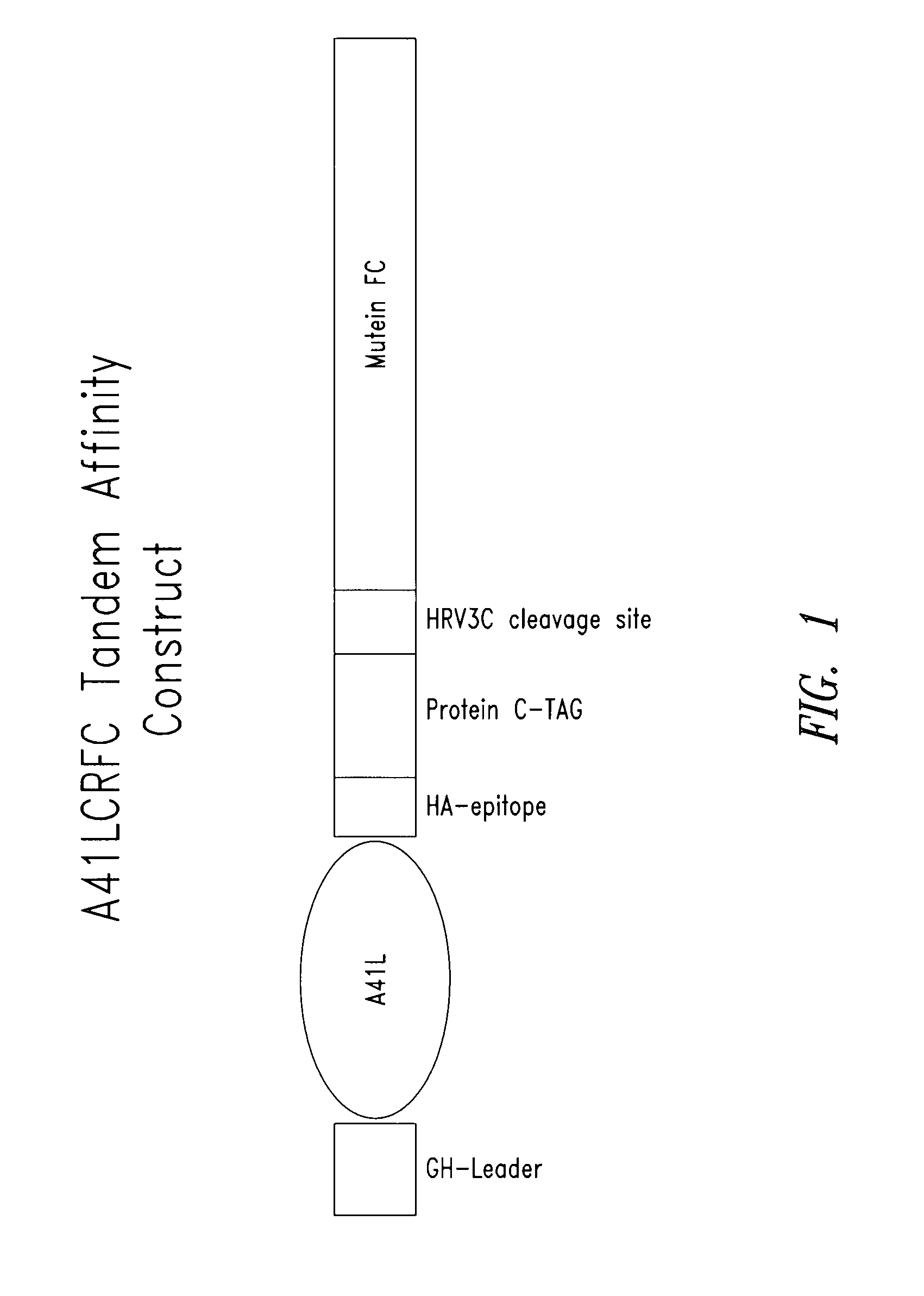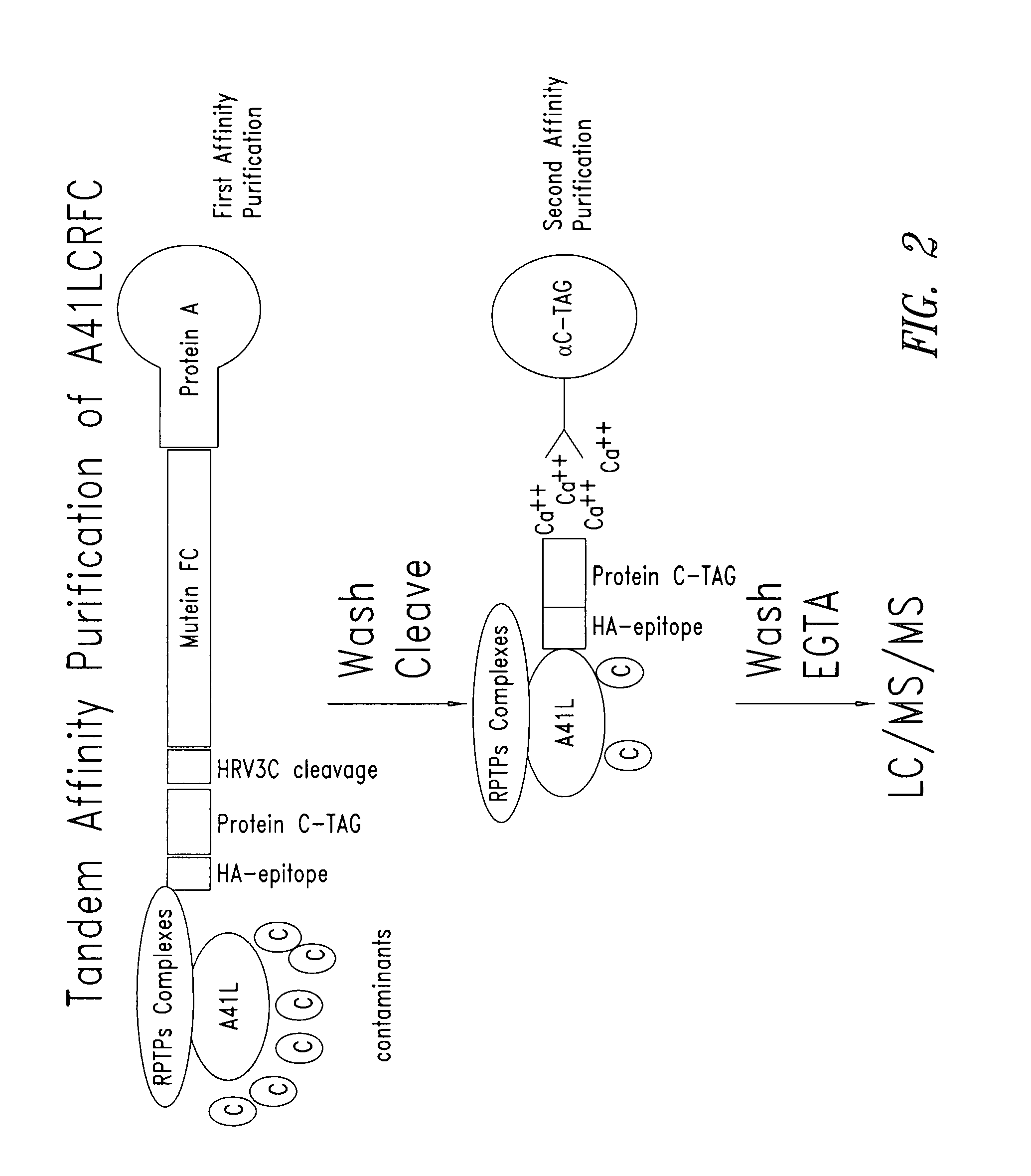Methods for identifying polypeptide targets and uses thereof for treating immunological diseases
a polypeptide and target technology, applied in the field of identifying cellular polypeptides, can solve the problems of affecting patient productivity, well-being, general health, etc., and achieve the effects of reducing the risk of developing a disease, increasing the virulence of a virus, and reducing at least one symptom
- Summary
- Abstract
- Description
- Claims
- Application Information
AI Technical Summary
Benefits of technology
Problems solved by technology
Method used
Image
Examples
example 1
Identification of RPTPs Expressed on Immune Cells that Bind A41L
[0251] This Example describes a method for identifying cell surface polypeptides that bind to A41L.
[0252] A recombinant expression vector comprising a polynucleotide that encoded a Cowpox A41L fusion polypeptide was constructed for a tandem affinity purification (TAP) procedure (also called TAP tag procedure) (see also, e.g., Rigaut et al. Nat. Biotech. 17:1030-32 (1999); Puig et al., Methods 24:218-29 (2001); Knuesel et al. Mol. Cell. Proteomics 2:1225-33 (2003)). The construct called A41LCRFC was prepared and the fusion polypeptide expressed and isolated according to standard molecular biology and affinity purification techniques and methods. A schematic of the construct is provided in FIG. 1. The A41 LCRFC construct included a nucleotide sequence that encoded a mature A41L coding sequence from Cowpox virus fused to the C-terminus of the human growth hormone leader peptide. The CRFC tandem affinity tag was fused to ...
example 2
Preparation of A41L-Fc Fusion Polypeptides
[0256] This example describes preparation of recombinant expression vectors for expression of an A41L-Fc fusion polypeptide and an A41L-mutein Fc fusion polypeptide.
[0257] Recombinant expression vectors were prepared according to methods routinely practiced by a person skilled in the molecular biology art. A polynucleotide encoding A41L-Fc and a polynucleotide encoding A41L-mutein Fc were cloned into the multiple cloning site of the vector, pDC409 (SEQ ID NO:41) (see, e.g., U.S. Pat. No. 6,512,095 and U.S. Pat. No. 6,680,840, and references cited therein). The amino acid sequence of the A41L-Fc polypeptide is set forth in SEQ ID NO:32, and the amino acid sequence of the A41L-mutein Fc polypeptide is set forth in SEQ ID NO: 31 (see FIG. 6). The nucleotide sequence that encodes the mutein Fc (human IgG1) polypeptide (SEQ ID NO:23) is set forth in SEQ ID NO:24. Ten to twenty micrograms of each expression plasmid were transfected into a HEK293...
example 3
Preparation of Affinity Tags for Fusion Polypeptides
[0258] This example describes preparation of recombinant expression vectors for expression of various affinity tags.
[0259] Fusion proteins, such as a fusion protein comprising a virulence factor polypeptide, or portion thereof, encoded by a viral virulence gene are fused in frame to an affinity tag for detection and / or isolation, for example, by tandem affinity purification (TAP). The fusion polypeptide may comprise more than one affinity tag. Recombinant expression vectors that comprise polynucleotide sequences encoding fusion proteins are prepared according to methods and techniques well known and routinely used by a person skilled in the molecular biology art (see also Example 2). As described herein, a fusion protein may further comprise at least one protease site. The polynucleotides encoding the fusion proteins may be inserted into any number of recombinant expression vectors available from commercial vendors and manufactur...
PUM
| Property | Measurement | Unit |
|---|---|---|
| mass | aaaaa | aaaaa |
| molecular weights | aaaaa | aaaaa |
| molecular weights | aaaaa | aaaaa |
Abstract
Description
Claims
Application Information
 Login to View More
Login to View More - R&D
- Intellectual Property
- Life Sciences
- Materials
- Tech Scout
- Unparalleled Data Quality
- Higher Quality Content
- 60% Fewer Hallucinations
Browse by: Latest US Patents, China's latest patents, Technical Efficacy Thesaurus, Application Domain, Technology Topic, Popular Technical Reports.
© 2025 PatSnap. All rights reserved.Legal|Privacy policy|Modern Slavery Act Transparency Statement|Sitemap|About US| Contact US: help@patsnap.com



